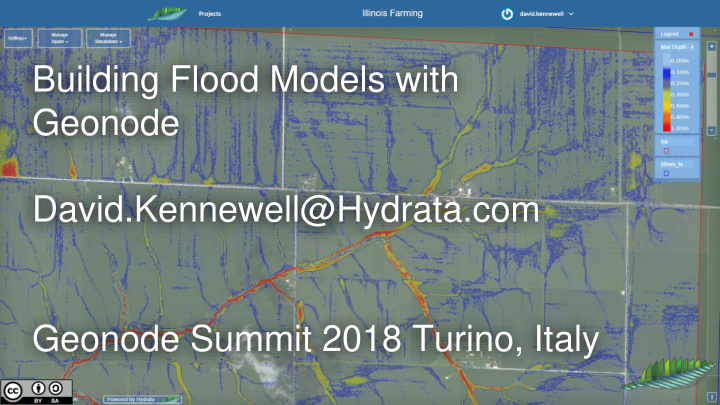



Building Flood Models with Geonode David.Kennewell@Hydrata.com Geonode Summit 2018 Turino, Italy
The ANUGA finite volume numerical model ● ANUGA is open-source software for the simulation of the shallow water equation. ● Open source development is led by the Australian National University and Geoscience Australia. ● Used to analyse flood, tsunami, dam-break, bridge design, river restoration, erosion management… ● Written in Python (most) and C (computational components) https://github.com/GeoscienceAustralia/anuga_core
Traditional Flood Study Online Flood Study vs ● Stored on a specialist’s hard -drive. ● Stored in Geonode. ● Hard to update. ● Update online. ● Hard to manage change. ● Can track change. ● Expensive licensing can restrict ● Open source model licensing stakeholder access for scenario allows for accessible scenario testing testing and collaboration.
Interactive demo: https://hydrata.com/anuga Training video: https://youtu.be/Xztwz3sEDvs GitHub: https://github.com/Hydrata
How does it work?
“Vanilla” Geonode Geonode/ Maploom Geonode Rest Api Django ORM Anugabase User Interface django app postgres Anuganode GSConfig compute machines Geonode_data Geoserver postgis GSConfig Amazon S3 Anugabase django app
Some lessons learned ● Commit to a cloud vendor, but no too much (for example, use IaaS, not Paas) ● Always script the server build process (for example: vagrant, shell scripts and ansible) ● The most effective way to namespace data in this case is to prepend identifiers onto any data filenames when they are uploaded or created: merewether_dem_myfreeformLayerNameHere.shp Project id Data type id Description 10 chars 3 chars the rest These datasets can then be filtered/classified/secured by the UI or APIs as required, anywhere in the app.
Please do get in touch. It would be great to: • Partner on a project together • Collaborate on Geonode development • Set you up with a free trial for hydrata.com • Receive feedback (bonus points for this!) david.kennewell@hydrata.com
Recommend
More recommend